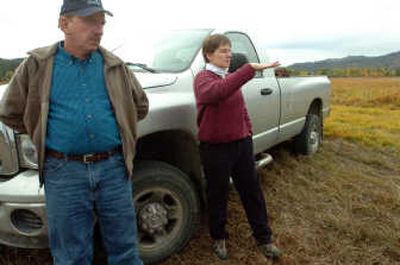Project restores safe wetlands

CATALDO, Idaho – On Monday, the swans were swimming and feeding in the marsh. A couple of days later, they were sluggish and barely moving. By Friday, the swans were dead – victims of lead poisoning.
The deaths happened a few years back, but the memory remains fresh for Anne Dailey, an environmental scientist with the U.S. Environmental Protection Agency.
Dozens, likely hundreds, of swans, waterfowl and songbirds die each year from toxic lead sediments in marshes along the lower Coeur d’Alene River, Dailey said. The federal government recently completed a project aimed at creating 400 acres of safe feeding havens for the birds.
An additional 15,000 acres along the river remain deadly, but Dailey said the wetland restoration project represents a step forward. “If you set up a safe area, the birds will come. But that doesn’t mean they won’t go elsewhere.”
The EPA has spent tens of millions of dollars trying to make the Silver Valley safe again for humans. The region was contaminated with lead, zinc and other heavy metals after a century of mining. The agency expects to spend $360 million over the next quarter century to neutralize the toxic legacy of the mines.
The safe waterfowl feeding area represents the first project aimed at making the area a bit less deadly for birds and wildlife, Dailey said.
The problem comes from toxic sediment that washed downstream from the Silver Valley mines. In some places along the river, the sediment is piled high as a house and has 10 times the concentration of lead that’s considered harmful to wildlife, Dailey said.
Waterfowl is hit especially hard during spring migrations, she said. The birds land in marshes to feed. With each gulp, they also take in sand and grit to help break down the plants. But lead in the sediment overwhelms their systems, shutting down the birds’ digestive tracts and causing them to starve to death on full bellies.
The U.S. Fish and Wildlife Service attempts to track waterfowl deaths each spring, but accurate counts are difficult because some birds sink after they die or take refuge in thick brush for their final hours, said agency spokesman Tom Buckley. The Fish and Wildlife Service previously estimated 92 percent of swan deaths along the Coeur d’Alene River are from lead poisoning. Nationwide, about 29 percent of swan deaths during migration are from lead.
In spring 2003, about 2,000 tundra swans landed in the marshes along the Lower Coeur d’Alene River. About 100 never took off again. The poisoned white remains of the dead swans were strewn across the wetlands like plastic bags.
The safe feeding area is being established in a field owned by Mike Schlepp, who previously grazed cattle and harvested hay from the acreage. Using money from a trust fund established by Asarco, one of the nation’s biggest polluters, the agency purchased an $875,000 conservation easement for the 400 low-lying acres along the river, Dailey said.
The land will remain privately owned by Schlepp, but it will never be developed.
A raised railroad bed separates the field from the river; the railroad has since been turned into the Trail of the Coeur d’Alenes bicycle path. The raised railroad berm has prevented floodwaters from sluicing the land with toxic sediment, Dailey said.
This summer, the EPA spent about $900,000 carving gently curving ditches into the fields and removing a drainage system that had been set up a century ago.
Clean water from a nearby creek will once again be allowed to spill over the land. Ducks Unlimited and the U.S. Fish and Wildlife Service also are working to replant native wetland vegetation in the field.
“It’s an area that wants to be wetlands,” Dailey said. “It’s already starting to get mucky out there.”
Schlepp said he’s looking forward to seeing waterfowl land on his fields next spring – and then take off.
“I’m really hopeful the swans spot this,” he said.
Bicycles now ride the rail path and birds will soon replace the cattle in the fields. Schlepp doesn’t mind.
“We’re just switching crops, that’s all,” he said, smiling. “It’s the end of one era and start of another.”